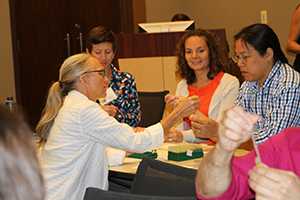Epidemiology in the Classroom

Teachers learning through a lab activity how epidemiology and laboratory science are used to investigate outbreaks.
Educators use EXCITE to provide examples of basic scientific concepts, principles, laws, and theories, promote critical thinking, and provide students with experience in data analysis and interpretation.
Teaching epidemiology to students:
- Improves reasoning and research skills
- Enhances ability to analyze and solve complex problems
- Teaches good health practices
How to Enrich Classroom Study of Public Health and Epidemiology
- Teach CDC Science Ambassador Lesson Plans in your classroom.
- Use examples of epidemiology and public health to enhance science and math lessons.
- Invite a local public health department professional (e.g., nurse, physician, epidemiologist, environmental health specialist) to discuss their role in epidemiology
- Invite an infectious diseases physician or an infection control nurse (i.e., infection preventionist) from a local hospital to discuss their role in epidemiology
- Introduce students to MMWR , CDC's weekly publication for timely, reliable, and useful public health information and recommendations
- Have students read public health–related literature (see the resource library)
- Have students research pioneers of public health and epidemiology, such as John Snow, Ignaz Semmelweis, John Graunt, Oliver Wendell Holmes Sr., William Farr, or Florence Nightingale
- Have students Solve the Outbreak using CDC's Mobile Activities, Solve the Outlook Application
- For more ideas, see EXCITE's resource library
- Page last reviewed: June 17, 2016
- Page last updated: June 17, 2016
- Content source:


 ShareCompartir
ShareCompartir